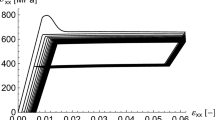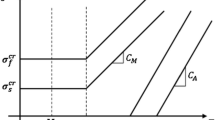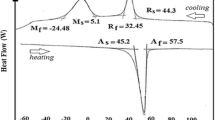Abstract
In this contribution, a thermodynamically consistent and mathematically canonical modelling framework for the investigation of the cyclic thermomechanical behaviour of Nickel-Titanium shape memory alloy wires is developed. Particular focus is placed on the self-heating of the material subjected to multiple load cycles. The relatively high load rates necessitates the consideration of inertia terms, the applied load amplitudes of six percent strain motivates the use of a non-linear, Hencky-type strain measure. Comparisons of the results with experimental data on the one hand reveal reasonable results and on the other hand underline the necessity of further model enhancements.









Similar content being viewed by others
Notes
A maximum of two simultaneously occurring interfaces is considered as this work proceeds.
In fact, a Hencky-type strain measure is used in this contribution, see Sect. 3.1 for details.
References
Abeyaratne R, Knowles J (1990) On the driving traction acting on a surface of strain discontinuity in a continuum. J Mech Phys Sol 38:345–360
Auricchio F, Reali A, Stefanelli U (2007) A three-dimensional model describing stress-induced solid phase transformation with permanent inelasticity. Int J Plast 23:207–226
Auricchio F, Petrini L (2004) A three-dimensional model describing stress-temperature induced solid phase transformations: thermomechanical coupling and hybrid composite applications. Int J Numer Methods Eng 61:716–737
Barrera N, Biscari P, Urbano MF (2014) Macroscopic modeling of functional fatigue in shape memory alloys. Eur J Mech A Solids 45:101–109
Bartel T, Menzel A, Svendsen B (2011) Thermodynamic and relaxation-based modeling of the interaction between martensitic phase transformations and plasticity. J Mech Phys Sol 59:1004–1019
Bartel T, Osman M, Menzel A (2016) A phenomenological model for the simulation of functional fatigue in shape memory alloy wires. Meccanica. doi:10.1007/s11012-016-0419-x
Biot MA (1965) Mechanics of incremental deformations. Wiley, New York
Coleman B, Noll W (1963) The thermodynamics of elastic materials with heat conduction and viscosity. Arch Ration Mech Anal 13:167–178
Demersa V, Brailovski V, Prokoshkinb SD, Inaekyana KE (2009) Thermomechanical fatigue of nanostructured Ti-Ni shape memory alloys. Mater Sci Eng A 513–514:185–196
Edelen DGB (1973) On the existence of symmetry relations and dissipation potentials. Arch Ration Mech Anal 51:218–227
Eggeler G, Hornbogen E, Yawny A, Heckmann A, Wagner M (2004) Structural and functional fatigue of Ni–Ti shape memory alloys. Mater Sci Eng A 378:24–33
Hartl D, Lagoudas D (2007) Aerospace applications of shape memory alloys. Proc Inst Mech Eng 221:535–552
Hartl DJ, Lagoudas DC (2009) Constitutive modeling and structural analysis considering simultaneous phase transformation and plastic yield in shape memory alloys. Smart Mater Struct 18:1–17
Hornbogen E (2004) Thermo-mechanical fatigue of shape memory alloys. J Mater Sci 39:385–399
Jani JM, Leary M, Subic A, Gibson MA (2014) A review of shape memory alloy research, applications and opportunities. Mater Design 2014:1078–1113
Kang G, Kan Q, Yu C, Song D, Liu Y (2012) Whole-life transformation ratchetting and fatigue of super-elastic niti alloy under uniaxial stress-controlled cyclic loading. Mater Sci Eng A 535:228–234
Lagoudas DC (2008) Shape memory alloys: modeling and engineering applications. Springer, Berlin
Li YF, Mi XJ, Tan J, Gao BD (2009) Thermo-mechanical cyclic transformation behavior of Ti-Ni shape memory alloy wire. Mater Sci Eng A 509:8–13
McCormick PG, Liu Y (1994) Thermodynamic analysis of the martensitic transformation in NiTi-II. Effect of transformation cycling. Acta Metall Mater 42(7):2407–2413
Merzouki T, Duval A, Zineb T (2012) Finite element analysis of a shape memory alloy actuator for a micropump. Simul Model Pract Theory 27:112–126
Miyazaki S, Igo Y, Otsuka K (1986) Effect of thermal cycling on the transformation temperatures of Ti-Ni alloys. Acta Metall 34(10):2045–2051
Müller I, Seelecke S (2001) Thermodynamic aspects of shape memory alloys. Math Comput Model 34:1307–1355
Nayan N, Buravalla V, Ramamurty U (2009) Effect of mechanical cycling on the stress–strain response of a martensitic Nitinol shape memory alloy. Mater Sci Eng A 525:60–67
Ostwald R, Bartel T, Menzel A (2012) Phase-transformations interacting with plasticity—a micro-sphere model applied to TRIP steel. Comput Mater Sci 64:12–16
Ostwald R, Bartel T, Menzel A (2015) An energy-barrier-based computational micro-sphere model for phase-transformations interacting with plasticity. Comput Methods Appl Mech Eng 293:232–265
Petrini L, Migliavacca F (2011) Biomedical applications of shape memory alloys. J Metall doi:10.1155/2011/501483
Robertson SW, Pelton AR, Ritchie RO (2012) Mechanical fatigue and fracture of nitinol. Int Mater Rev 57(1):1–37
Souza AC, Mamiya EN, Zouain N (1998) Three-dimensional model for solids undergoing stress-induced phase transformations. Eur J Mech A Solids 17:789–806
Truesdell C, Noll W (1965) The non-linear field theories of mechanics. Springer, Berlin
Wolfram S (2016) NMinimize—Wolfram language documentation (2016). https://reference.wolfram.com/language/ref/NMinimize.html
Yawny A, Olbricht J, Sade M, Eggeler G (2008) Pseudoelastic cycling and ageing effects at ambient temperatures in nanocrystalline Ni-rich NiTi wire. Mater Sci Eng A 481–482:86–90
Yin H, He Y, Sun Q (2014) Effect of deformation frequency on temperature and stress oscillations in cyclic phase transition of NiTi shape memory alloy. J Mech Phys Sol 67:100–128
Ziegler H (1963) Some extremum principles in irreversible thermodynamics with application to continuum mechanics. No. IV in progress in solid mechanics. North-Holland Publishing Company, North-Holland
Author information
Authors and Affiliations
Corresponding author
Additional information
An erratum to this article is available at http://dx.doi.org/10.1007/s10704-016-0169-8.
Rights and permissions
About this article
Cite this article
Bartel, T., Menzel, A. Modelling and simulation of cyclic thermomechanical behaviour of NiTi wires using a weak discontinuity approach. Int J Fract 202, 281–293 (2016). https://doi.org/10.1007/s10704-016-0156-0
Received:
Accepted:
Published:
Issue Date:
DOI: https://doi.org/10.1007/s10704-016-0156-0




